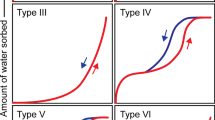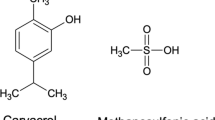Abstract
A relatively new approach for wood protection against fungal decay is based on hydrophobization of wood and on lowering its moisture content. Water repellence of wood can be increased by polymerization of hydrophobic monomers in wood cell walls. It was found that Norway spruce wood after treatment with octadecyltrichlorosilane exhibited reduced water uptake by the wood cell walls, lowered water vapour sorption, and significantly increased dimensional stability of wood in terms of anti-swelling efficiency. Hydrophobicity and lower equilibrium moisture content were shown to cause increased resistance of the treated samples against brown-rot decay and molds.








Similar content being viewed by others
References
Ashurst WR, Yau C, Carraro C, Lee C, Kluth GJ, Howe RT, Maboudian R (2001) Alkene based monolayer films as anti-stiction coatings for polysilicon MEMS. Sens Actuators A 91(3):239–248
Bourlinos AB, Chowdhury SR, Jiang DD, An YU, Zhang Q, Archer LA, Giannelis EP (2005) Layered organosilicate nanoparticles with liquid like behavior. Small 1(1):80–82
BS EN 113 (1997) Wood preservatives. Test method for determining the protective effectiveness against wood destroying basidiomycetes. Determination of the toxic values
Carll G, Highley TL (1999) Decay of wood and wood-based products above ground in buildings. J Test Eval 27(2):150–158
CEN/TS 15083-1 (2006) Durability of wood and wood-based products. Determination of the natural durability of solid wood against wood-destroying fungi, test methods. Part 1: basidiomycetes
CEN/TS 15119-1 (2008) Durability of wood and wood-based products. Determination of emissions from preservative treated wood to the environment. Part 1: wood held in the storage yard after treatment and wooden commodities exposed in use class 3
CEN/TS 15119-2 (2013) Durability of wood and wood-based products. Determination of emissions from preservative treated wood to the environment. Part 2: wooden commodities exposed in use class 4 or 5
De Vetter L, Stevens M, Van Acker J (2009) Fungal decay resistance and durability of organosilicon-treated wood. Int Biodeterior Biodegrad 63(2):130–134
Donath S, Militz H, Mai C (2004) Wood modification with alkoxysilanes. Wood Sci Technol 38(7):555–566
Donath S, Militz H, Mai C (2006) Treatment of wood with aminofunctional silanes for protection against wood destroying fungi. Holzforschung 60(2):210–216
Dubey MK, Pang S, Walker J (2012) Changes in chemistry, color, dimensional stability and fungal resistance of Pinus radiata D. Don wood with oil heat-treatment. Holzforschung 66(1):49–57
Engelund ET, Thygesen LG, Svensson S, Hill CA (2013) A critical discussion of the physics of wood–water interactions. Wood Sci Technol 47(1):141–161
Filley TR, Cody GD, Goodell B, Jellison J, Noser C, Ostrofsky A (2002) Lignin demethylation and polysaccharide decomposition in spruce sapwood degraded by brown rot fungi. Org Geochem 33(2):111–124
Glass SV, Zelinka SL (2010) Moisture relations and physical properties of wood. Wood handbook: wood as an engineering material: chapter 4. Centennial ed. General technical report FPL; GTR-190. U.S. Dept. of Agriculture, Forest Service, Forest Products Laboratory, Madison, pp 4.1–4.19
Goethals P, Stevens M (1994) Dimensional stability and decay resistance of wood upon modification with some new type chemical reactants. IRG/WP 94-40028. The International Research Group on Wood Protection, Stockholm
Hill CA (2007) Wood modification: chemical, thermal and other processes, vol 5. Wiley, New York
Hill CAS, Farahani MRM, Hale MDC (2004) The use of organo alkoxysilane coupling agents for wood preservation. Holzforschung 58(3):316–325
Hrovatin J, Jeram G, Kuzman M, Pohleven F (2009) Influence of construction on wetting of wooden fences. Wood Res 54(1):113–124
Humar M, Lesar B (2013) Efficacy of linseed- and tung-oil-treated wood against wood-decay fungi and water uptake. Int Biodeterior Biodegrad 85:223–227
ISO 11341 (2004) Paints and varnishes—artificial weathering and exposure to artificial radiation—exposure to filtered xenon-arc radiation
Jalaludi Z, Hill CAS, Samsi HW, Husain H, Xie Y (2010) Analysis of water vapour sorption of oleo-thermal modified wood of Acacia mangium and Endospermum malaccense by a parallel exponential kinetics model and according to the Hailwood-Horrobin model. Holzforschung 64(6):763–770
Kamdem DP, Pizzi A, Jermannaud A (2002) Durability of heat-treated wood. Eur J Wood Wood Prod 60(1):1–6
Keplinger T, Cabane E, Chanana M, Hass P, Merk V, Gierlinger N, Burgert I (2015) A versatile strategy for grafting polymers to wood cell walls. Acta Biomater 11:256–263
Korner S, Pecina H, Wienhaus O (1990) Investigations on the identification of the beginning brown-rot fungus infestation of wood by means of IR spectroscopy. Holz als Roh- und Werksto 7(48):413–416
Korner I, Faix O, Wienhaus O (1992) Attempt to determine brown-rot breakdown of scots pine wood with the aid of FTIR spectroscopy. Holz als Roh- und Werksto 7(50):363–367
Kudanga T, Nugrohojo E, Prasetyo J, Sipilä P, Nousiainen P, Widsten A, Kandelbauer G, Nyanhongo S, Guebitz G (2008) Laccase-mediated wood surface functionalization. Eng Life Sci 8(3):297–302
Kumar A, Petrič M, Kričej B, Žigon J, Tywoniak J, Hajek P, Pavlič M (2015) Liquefied wood based polyurethane-nanosilica hybrid coatings and hydrophobization by self-assembled monolayers of orthotrichlorosilane (OTS). ACS Sustain Chem Eng 3(10):2533–2541
Lesar B, Humar M (2011) Use of wax emulsions for improvement of wood durability and sorption properties. Eur J Wood Prod 69(2):231–238
Lesar B, Pavlič M, Petrič M, Škapin AS, Humar M (2011) Wax treatment of wood slows photodegradation. Polym Degrad Stab 96(7):1271–1278
Mahltig B, Arnold M, Löthman P (2010) Surface properties of sol–gel treated thermally modified wood. J Sol–Gel Sci Technol 55(2):221–227
Mohammed-Ziegler I, Oszlánczi Á, Somfai B, Hórvölgyi Z, Pászli I, Holmgren A, Forsling W (2004) Surface free energy of natural and surface-modified tropical and European wood species. J Adhes Sci Technol 18(6):687–713
Mohammed-Ziegler I, Hórvölgyi Z, Toth A, Forsling W, Holmgren A (2006) Wettability and spectroscopic characterization of silylated wood samples. Polym Adv Technol 17(11–12):932–939
Pandey KK, Pitman AJ (2003) FTIR studies of the changes in wood chemistry following decay by brown-rot and white-rot fungi. Int Biodeterior Biodegrad 52(3):151–160
Panov D, Terziev N (2009) Study on some alkoxysilanes used for hydrophobation and protection of wood against decay. Int Biodeterior Biodegrad 63(4):456–461
Parikh AN, Schivley MA, Koo E, Seshadri K, Aurentz D, Mueller K, Allara DL (1997) n-Alkylsiloxanes: from single monolayers to layered crystals. The formation of crystalline polymers from the hydrolysis of n-octadecyltrichlorosilane. J Am Chem Soc 119(13):3135–3143
Petrič M (2013) Surface modification of wood. Rev Adhes Adhes 1(2):216–247
Petrič M, Oven P (2015) Determination of wettability of wood and its significance in wood science and technology: a critical review. Rev Adhes Adhes 3(2):121–187
Podgorski L, Chevet B, Onic L, Merlin A (2000) Modification of wood wettability by plasma and corona treatments. Int J Adhes Adhes 20(2):103–111
Popescu C-M, Hill CAS, Curling S, Ordmondroyd G, Xie Y (2014) The water vapour sorption behaviour of acetylated birch wood: how acetylation affects the sorption isotherm and accessible hydroxyl content. J Mater Sci 49(5):2362–2371
Rautkari L, Hill CA, Curling S, Jalaludin Z, Ormondroyd G (2013) What is the role of the accessibility of wood hydroxyl groups in controlling moisture content? J Mater Sci 48(18):6352–6356
Rowell RM (2005) Chemical modification of wood. Handbook of wood chemistry and wood composites, CRC Press, pp 447–457
Rowell RM (2006) Chemical modification of wood: a short review. Wood Mater Sci Eng 1:29–33
Tjeerdsma BF, Boonstra M, Pizzi A, Tekely P, Militz H (1998) Characterisation of thermally modified wood: molecular reasons for wood performance improvement. Eur J Wood Wood Prod 56(3):149–153
Wang X, Chai Y, Liu J (2013) Formation of highly hydrophobic wood surfaces using silica nanoparticles modified with long-chain alkylsilane. Holzforschung 67(6):667–672
Xie Y, Hill CAS, Xiao Z, Jalaludin Z, Militz H, Mai C (2010) Water vapor sorption kinetics of wood modified with glutaraldehyde. J Appl Polym Sci 117(3):1674–1682
Acknowledgments
This research work was supported by the European social fund within the framework of realizing the project “Support of inter-sectoral mobility and quality enhancement of research teams at Czech Technical University in Prague”, CZ.1.07/2.3.00/30.0034. Financial support of the Slovenian Research Agency through the research programme P4-0015 “Wood and lignocellulose composites” is also gratefully acknowledged.
Author information
Authors and Affiliations
Corresponding authors
Ethics declarations
Conflict of interest
The authors declare no competing financial interest.
Rights and permissions
About this article
Cite this article
Kumar, A., Ryparová, P., Škapin, A.S. et al. Influence of surface modification of wood with octadecyltrichlorosilane on its dimensional stability and resistance against Coniophora puteana and molds. Cellulose 23, 3249–3263 (2016). https://doi.org/10.1007/s10570-016-1009-8
Received:
Accepted:
Published:
Issue Date:
DOI: https://doi.org/10.1007/s10570-016-1009-8




